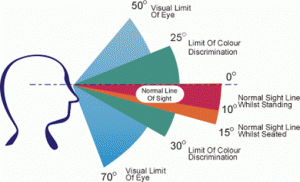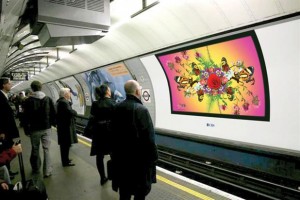When considering where to best place a digital signage screen it is always best to consider the way that the human eye works.
There are two primary parameters to consider when looking for the ideal location for your screen, the first being ‘cone of vision’, and the second being ‘Eccentricity’.
The cone of vision is the area that your eye works the best in terms of detecting things that are likely to make a lasting impression.  For example we know from our own eyes, that things that appear in the periphery of our vision are extremely hard to make detail out, and other than rapid movement (we are at heart still predators and are also prey) things here are difficult to cognitively identify. Likewise we know that items that appear directly in our field of vision are sharp and easily identified, and are therefore far more likely to make an impression upon us. Our main Cone of Vision is identified as 60° left and 60° right making 120° in total. So when planning where to place your screen, try and imagine the location from a viewers perspective, i.e how easy is it to see clearly without moving one’s head? This is just as important in a seated area as it is in an area where the audience is moving.
For example we know from our own eyes, that things that appear in the periphery of our vision are extremely hard to make detail out, and other than rapid movement (we are at heart still predators and are also prey) things here are difficult to cognitively identify. Likewise we know that items that appear directly in our field of vision are sharp and easily identified, and are therefore far more likely to make an impression upon us. Our main Cone of Vision is identified as 60° left and 60° right making 120° in total. So when planning where to place your screen, try and imagine the location from a viewers perspective, i.e how easy is it to see clearly without moving one’s head? This is just as important in a seated area as it is in an area where the audience is moving.
Once we have considered the cone of vision the other related item is what is called eccentricity. This is not being eccentric as in weird and wacky !!, but rather how off axis is the digital signage screen (or poster) in relation to the viewer (who may well be moving). By way of an example consider the two different advertising locations in the same venue (London Underground).
 The image on the left shows a typical underground advertisement location, which of course due to the pretty unique structural limitations of the tube means that advertising is almost always placed to the left or right of the viewers path, meaning the image is not directly seen unless looked at directly, and this means moving the viewer’s head while they are moving.
The image on the left shows a typical underground advertisement location, which of course due to the pretty unique structural limitations of the tube means that advertising is almost always placed to the left or right of the viewers path, meaning the image is not directly seen unless looked at directly, and this means moving the viewer’s head while they are moving.
The image on the right show a cross track advertisement that is very much on axis to the natural position of the viewer.
Does this mean that screens mounted off axis to the viewer are no good? No of course not, just like when faced with nowhere else to place these posters advertising companies will use the off axis location rather than nowhere at all, it just means that an area such as cross track, although it may be a far rarer commodity than the many walls of the corridors, carries a higher value as it is more likely for the content to be acknowledged by a visitor to that location.
So in summary think about the field of vision and the journey for your target audience when looking at the best location for a digital signage screen, in order to maximise it’s effectiveness.

